History of Kirov
Foundation of Vyatka
The first settlements on the territory of present-day Kirov appeared about 2.5 thousand years ago. By the 7th century, the first Udmurt, Mari, and Komi tribes formed on the territory of this region. The Russians came to the basin of the Vyatka River in the second half of the 12th century.
Local legends speak of the arrival of two detachments of Novgorodians who founded the first Russian settlements on the Vyatka River - Nikulitsyn and Kotelnich. Following this, they decided to create a single center and founded a settlement named Vyatka in 1181.
Mass migration to the Vyatka region began after the Mongol invasion in the mid-13th century. The first mention of the town of Vyatka (Vyatka land) in Russian chronicles dates from 1374, in connection with the campaign of Novgorodians on Bulgar, the capital of Volga Bulgaria.
In 1455-1457, a wooden fortress (kremlin) called Khlynov was built in the town. After two military campaigns of the Moscow army against Khlynov in 1457 and 1459, power in the town formally passed to Moscow, but with the preservation of local self-government. Locals participated in military campaigns of the Moscow Principality against Novgorod and Kazan.
More Historical Facts…
Khlynov in the 16th-18th centuries
In 1551-1552, the Khlynov troops took part in the campaign of Ivan the Terrible against the Kazan Tatars. In 1554-1556, they participated in campaigns against the Astrakhan Khanate. As a result of these campaigns, the original lands captured earlier by the Golden Horde and then by the Tatar khanates were returned to Khlynov.
In 1580, Khlynov received a written permission from Ivan the Terrible to build a monastery in the town, named after the abbot founder Tryphon. By the end of the 16th century, due to the liquidation of the Siberian Khanate, the Vyatka land ceased to be the outskirts of the Russian state.
It became an important link between the central, Volga, northern, and Ural-Siberian regions. At that time, the village of Dymkovo appeared nearby. Its residents founded one of the famous Russian folk crafts - making of painted clay toys.
In the 17th century, Khlynov was the largest town in the north-east of European Russia. In the middle of the 17th century, about 4,400 people lived in it. In 1689, the Assumption Cathedral of the Trifonov Monastery was built - one of the first stone buildings in Khlynov. In 1694, the local merchant Spiridon Lyanguzov organized the first trade caravan from Moscow to China after the conclusion of the Russian-Chinese agreement, which allowed mutual trade.
In 1708, Khlynov, along with the Vyatka region, was included in the Siberian Governorate. In 1722-1723, the first poll census was carried out in Khlynov. According to it, there were 2,276 residents in the town (without women). In 1727, the first elementary school was opened in Khlynov.
Since 1744, the postal service began to develop, communication was established with Moscow, Kazan, and Siberia. Khlynov rapidly expanded trade relations. Two annual fairs were regularly held in the town. Local merchants traded with Moscow, St. Petersburg, Astrakhan, Kazan, Siberia, and continued trade with China.
Vyatka in the late 18th - early 20th centuries
In 1780, by decree of Empress Catherine II, the Khlynov Governorate was formed, which was soon transformed into the Vyatka Governorate. The town of Khlynov was renamed Vyatka. In 1781, the coat of arms of Vyatka was approved. The town was under active construction of stone churches and civil buildings. In 1797, the town’s oldest industrial enterprise was founded - the regional printing house. In 1799, the first private pharmacy was opened.
Vyatka became a place of political exile. The exiles played a big role in its social life, the development of culture. Alexander Herzen and Mikhail Saltikov-Shedrin were exiled to Vyatka. The memory of the exiled Poles, participants of the national liberation movement, is preserved in Aleksandrovskiy Catholic Church, which houses the organ concert hall today.
The first hospital was opened in 1823. In 1858, the territory of the Vyatka Governorate was one of the largest in Russia. In 1866, the museum of local lore was opened, one of the oldest in Russia. In 1897, according to the All-Russian Census, more than 3 million people lived in this region of the Russian Empire. The population of Vyatka was about 25 thousand people.
In 1899, the railway connected Vyatka with Perm and Kotlas. Since 1906, the movement of trains across the Volga to St. Petersburg began. The city had a power plant that illuminated the central streets and water supply.
In 1908, the first movie theaters opened. In January 1909, on the way to the place of exile in the town of Solvychegodsk, Joseph Stalin fell ill with typhus and spent some time in the hospital in Vyatka. In 1912, the botanical garden was laid. In 1916, the city library was founded.
Kirov in the 20th century
In 1926, according to the All-Union Census, the population of Vyatka was 62,097 people. In 1929, an administrative-territorial reform took place. The Vyatka Governorate was liquidated, its territory became part of the Nizhny Novgorod Krai. The city of Vyatka became a district center.
On December 5, 1934, in memory of Sergei Kirov, a Soviet politician and revolutionary assassinated on December 1, 1934, Vyatka was renamed Kirov and a separate Kirov Krai was formed. In 1936, in connection with the adoption of the new Soviet Constitution, Kirov Krai was transformed into Kirov Oblast, and the Udmurt Autonomous Region was separated from it and transformed into the Udmurt Autonomous Soviet Socialist Republic. In 1939, the population of Kirov was 143,558 people.
During the Second World War, several heavy metallurgy and defense plants were transported from the frontline territories to Kirov Oblast. More than 600 thousand residents of the region carried army service, 257.9 thousand of them were killed during the war.
In the postwar decades, on the basis of evacuated enterprises, the machine-building, metalworking, instrument-making, and chemical industries developed in Kirov. In the 1950s-1960s, Kirov was completely built up with brick houses. All its roads were paved, the construction of many social infrastructure facilities (schools, kindergartens, hospitals) was completed. In 1962, the first bridge over the Vyatka River was built in Kirov.
By 1967, the population of Kirov exceeded 300 thousand people. On May 25, 1968, two explosions occurred almost simultaneously under the main tribune of the “Labor Reserves” stadium, under which there was an office building with stored pyrotechnics. As a result, several dozen people died and about a hundred were injured.
In 1970, Kirov received the status of a historical city. On December 23, 1977, the grand opening of the new building of the Kirov Circus took place. In 1989, the population of Kirov was 440,240 people.
Today, Kirov is an important historical, cultural, industrial, and scientific center of the European part of Russia.
Pictures of Kirov
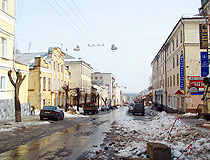
One of the streets in Kirov
Author: Ilya Buyanovsky
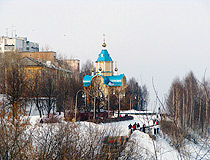
Winter in Kirov
Author: Ilya Buyanovsky
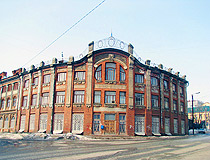
Old building in Kirov
Author: Ilya Buyanovsky
Kirov - Features
Kirov is the most eastern city founded during the time of Kievan Rus and one of the oldest cities in the north-east of Russia. Located in the taiga forest zone, it stands in the valley of the Vyatka River. Thanks to its name, this city and the entire Kirov region is often called Vyatka. The distances to the nearest major cities: Kazan - 395 km, Perm - 492 km, Nizhny Novgorod - 577 km, Ufa - 747 km, Samara - 741 km.
In the Orthodox tradition, a bow and arrow depicted on the coat of arms of Kirov symbolize unbaptized, barbaric peoples. A lot of non-Slavic peoples (Mari, Udmurts, Tatars) lived in the Vyatka region, when the town was founded. A cross was added to soften the pagan symbolism of the coat of arms. A hand with a bow coming out of the cloud symbolizes the special tactics of warfare practiced by local tribes - small squads carrying out quick attacks.
The territory of Kirov belongs to the continental climate of the temperate zone. Due to the proximity to the Arctic Ocean and the absence of barriers for the penetration of polar air masses, intrusions of cold air are possible, causing severe frosts in the winter and frosts, sudden cooling in the summer. The average temperature in January is minus 11.9 degrees Celsius, in July - plus 18.9 degrees Celsius.
Kirov is a major railway junction of the Trans-Siberian Railway. Railways run through the city to Nizhny Novgorod, Moscow, Vologda, Kotlas, St. Petersburg, Perm. Pobedilovo Airport in Kirov offers regular flights to Moscow, St. Petersburg, Naryan-Mar, Sochi.
Enterprises located on the territory of Kirov are known in Russia and beyond for their products of aircraft, woodworking, heavy engineering, machine tools, light, and food industries. The production of handicrafts is also relatively well developed (famous Dymkovo toys, Vyatka lace, souvenirs made from burls, birch bark).
Kirov has 11 historical monuments, 22 architectural monuments, 3 art monuments, and 1 archeology monument of federal (all-Russian) significance. Also there are 54 cultural monuments of regional significance, as well as 19 specially protected natural territories.
Main Attractions of Kirov
Holy Assumption Trifonov Monastery. The monastery was founded by the saint Tryphon of Vyatka in 1580. The architectural ensemble of this monastery has the status of an architectural monument of federal significance. The Assumption Cathedral (1684-1689) of the monastery is the oldest building in Kirov. In total, the monastery complex includes almost 20 buildings. Gorbacheva Street, 4.
Cathedral of Seraphim of Sarov (1907). This church has pronounced features of a traditional Russian church, but with a predominance of the modern style of the early 20th century. Black domes, a spectacular combination of red and white bricks with green insertions - all these details give the church a bright and very picturesque look. Uritskogo Street, 25.
Alexander Catholic Church (1903). It was built at the request of exiled Poles, who lived in the Vyatka Governorate. Services continued until 1933, despite the fact that most parishioners had left the region after 1917. Later, the building was used as a veterinary institute. In the 1990s, the church was restored, a concert hall of organ and chamber music was opened in it. Derendyayeva Street, 46.
Alexander Garden - the oldest park in the city and region founded after the visit of the Emperor Alexander I in the first half of the 19th century. It is still decorated with a rotunda, an entrance portico, and a fence built in the 1840s. These objects are made in the classical style and are one of the best examples of landscape gardening architecture. The park has a lot of sculptures and art objects installed in Soviet and modern times.
Alexander Green Embankment running along the Vyatka River. From here, you can enjoy beautiful views of the river, Kirov, and Dymkovskaya sloboda. The alleys are densely planted with trees and ornamental shrubs. The embankment was named after the famous writer Alexander Green, a native of the Vyatka Governorate.
Spasskaya Street - a historical street that appeared in Kirov at the end of the 18th century. Its pedestrian paved part runs along picturesque old mansions. In the center of the street there are wrought iron lamps, benches, and flowerpots. Most of the historical buildings date back to the 19th - early 20th centuries.
Vyatka Paleontological Museum. This museum was opened on the basis of a vast collection of Permian vertebrate fossils (about 260 million years old) found on the Kotelnichsky Pareiasaurus State Nature Monument. Here you can find a lot of unique exhibits. About 100 km from the museum, there is a huge cemetery of the remains of ancient animals stretching for 25 km along the Vyatka River. In the summer, visitors to the museum are invited to take part in excursion tours to the excavation site. Spasskaya Street, 22.
Kirov Regional Museum of Local Lore - one of the oldest regional museums in Russia. The main exposition covers the history of the peoples of the Vyatka region from the Paleolithic to the present day. The ethnographic collection presents household items and clothing of such peoples as Udmurts, Mari, Komi, Tatars, and Russians. The pride of the museum is a rich numismatic collection of 45 thousand coins and notes. In the hall of old weapons you can see a model of the wooden Vyatka Kremlin. Spasskaya Street, 6.
Vyatka Art Museum named after V.M. Vasnetsov and A.M. Vasnetsov - the first art and historical museum in the North and North-East of Russia. The collection of the museum has more than 22 thousand works of painting, graphic art, sculpture, decorative, and folk art. In the gallery you can see the masterpieces of famous artists: I. E. Repin, K. P. Bryullov, I. K. Aivazovsky, and a number of others. Karla Marksa Street, 70.
Museum “The Dymkovo Toys: History and Modernity”. The exposition of this museum is dedicated to the traditional craft of the Vyatka region - the Dymkovo (Vyatka) toys. It consists of more than 700 items (about 250 are exhibited simultaneously). Here you can see both classic, familiar products of Dymkovo masters, as well as new ones with different designs. In addition, the museum often hosts exhibitions on other areas of decorative art. Svobody Street, 67.
Mansion of the Merchant Bulychev (1911) - one of the most beautiful buildings in Kirov built at the expense of Tikhon Bulychev, a merchant and owner of the Volga-Kama Shipping Company. Resembling a fairytale castle, it was constructed in an eclectic style with Gothic, oriental, and classical elements. Lenina Street, 96.


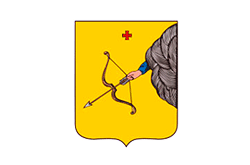
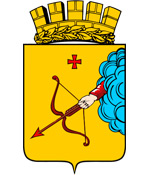




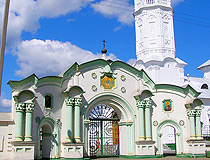
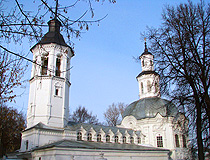
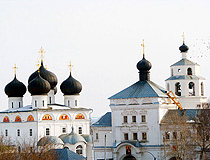
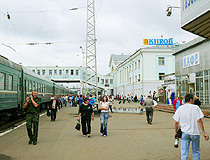
The comments of our visitors
All 11 comments